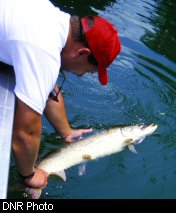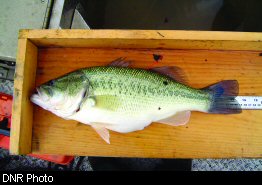

Setting Some Limits Helps Fish PopulationsBy Zack Brown
Statewide harvest regulations have been implemented for 20 fish species or groups of species. Examples of statewide harvest regulations include the creel limit of six fish for largemouth bass and the 30-inch minimum size limit on muskellunge. In addition to statewide regulations, several species are managed under special regulations. A special regulation is tailored for a certain species or area with a specific goal in mind. These regulations are typically broken down into harvest limits and size limits including minimum size limits, slot-limits, and catch-and-release restrictions. The goal of regulation for warmwater fish is usually aimed at increasing angler catch rate or shifting the size-structure of the fish population. Creel Limits One of the most basic forms of regulation is limiting the number of fish harvested, called a creel limit. A daily creel limit on certain fish can prevent populations from being over-harvested. A bass population in a small lake could be decreased significantly if anglers kept every fish they caught. Minimum Size Limits Minimum size limits require the release of all fish less than a certain length and are often used in conjunction with creel limits to protect fish until they are old enough to reproduce. Minimum size limits are recommended for fish species that grow quickly, have low survival of young fish, and experience high harvest by anglers. If a minimum size limit is the correct regulation for a particular species and water, then Slot limits A slot-limit regulation requires that all fish within a protected size-class be returned to the water. For example, East Lynn Lake has a 12- to 16-inch slot limit on black bass, so all smallmouth, largemouth and spotted bass caught between 12- and 16-inches-long must be released immediately. Slot-limits are usually recommended for fish populations that have high survival of young fish, slow growth rates and potentially high angler harvest. The main objective of a slot limit is to increase the number of larger fish in a population. For a slot-limit to work properly, small fish MUST be harvested. This reduces the competition for food among young fish and allows the fish not harvested to grow faster. If small fish are not harvested the regulation becomes, in effect, a high minimum size limit. Sometimes the size structure of the population will still shift to larger fish, but not as effectively, and growth rates may slow even more from increased competition. Catch-and-Release Regulations The DNR has two main reasons for enacting a catch-and-release harvest regulation. The first reason is to create a trophy fishery. By eliminating the harvest of fish, the DNR provides a unique opportunity for individual fish to grow as large as they can in a particular habitat. The DNR has implemented a catch-and-release regulation for black bass on most public lakes impounded since 1989. The regulation has provided excellent fishing for many years on waters like Stonewall Jackson, Upper Mud and Woodrum lakes.The high number of lunker bass in these lakes would not have lasted so long under the statewide regulations. The second reason to use a catch-and-release regulation is to protect rare species of fish. Currently the DNR provides this protection to paddlefish, the shovelnose sturgeon and the lake sturgeon. Why limits are important Creel limits, size limits, and catch-and-release regulations are important tools biologists use to manage fish populations. Each type of regulation has a specific purpose. Before a special regulation is placed on a species, DNR Wildlife Resources Section fisheries biologists need to study the existing population in order to predict the impact of the regulation and to provide baseline numbers which will be used later to measure the effectiveness of the regulation. They must also factor in the needs and wants of anglers who use the resource. By doing this, the DNR can better meet its mission of conserving the fish populations of the state while providing diverse fishing opportunities to West Virginia's anglers. Zack Brown is a District Fisheries Biologist stationed at McClintic WMA. |
 West Virginia 's warmwater lakes and streams contain a wide variety of sportfish that are highly sought by the state's anglers. Largemouth and smallmouth bass, channel catfish, walleye and muskellunge are among the most sought after species. These populations need to be properly managed in order to provide sustained quality fishing. One tool biologists use to manage fish populations is harvest regulation.
West Virginia 's warmwater lakes and streams contain a wide variety of sportfish that are highly sought by the state's anglers. Largemouth and smallmouth bass, channel catfish, walleye and muskellunge are among the most sought after species. These populations need to be properly managed in order to provide sustained quality fishing. One tool biologists use to manage fish populations is harvest regulation.  angler catch rates should go up as the population increases. Angler harvest rates, the number of fish the angler keeps, may go down due to the fact that small fish can no longer be kept, but catch rates should increase as small fish are caught and released with an opportunity to be caught again. When size limits are incorrectly applied, competition for food among young fish increases. This can lead to having an abundant population of small fish with few larger individuals.
angler catch rates should go up as the population increases. Angler harvest rates, the number of fish the angler keeps, may go down due to the fact that small fish can no longer be kept, but catch rates should increase as small fish are caught and released with an opportunity to be caught again. When size limits are incorrectly applied, competition for food among young fish increases. This can lead to having an abundant population of small fish with few larger individuals.